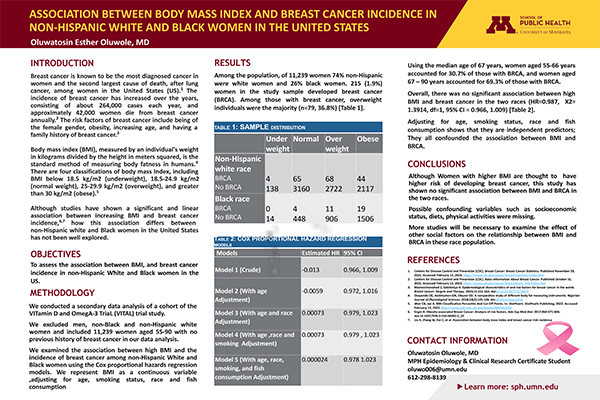Oluwatosin Oluwole
MPH, Epidemiology
Advisor:
David Jacobs
Keywords:
Breast cancer, Body Mass Index
Abstract
Introduction: Breast cancer, the second largest cause of death in the United States (US), accounts for about 264,000 incident cases and approximately 42,000 deaths in women annually, hence an issue of public health importance. Studies have identified being of the female gender, Obesity, and a family history of breast cancer as risk factors. This study aims to determine the association between BMI, an index of Obesity, and breast cancer incidence in non-Hispanic White and Black women in the US.
Methods: We conducted a secondary data analysis of a cohort of the VITamin D and OmegA-3 TriaL (VITAL) trial study. We excluded men, non-Black and non-Hispanic white women and included 11391 women aged 55-90 with no previous history of breast cancer in our data analysis. Using the SAS OnDemand software, we examined the association between high BMI and the incidence of breast cancer among non-Hispanic White and Black women using the Cox proportional hazards regression models.
Results: The study sample of 218 women include 84% non-Hispanic white women and 16% black women. There was no difference in the association between high BMI and breast cancer in the two races (HR=0.83, X2= 1.46, df=1, p=0.22). Adding age to the model shows that it is an independent predictor of breast cancer (HR= 1.03, X2=11.3, df=1, p= 0.0008).
Conclusion: To adequately limit the risk of breast cancer in women, public health efforts should be channeled towards weight control and more screenings for early detection of breast cancer in all women of increasing age.

View Poster (PDF)
